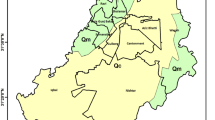Abstract
A geographical information system (GIS) assisted approach that couples a groundwater flow model and an inverse geochemical model is presented to quantify the phase mole transfers between two points on the flow path within a groundwater system. It is used to investigate the plausible phase transfers in the unconfined aquifer of Mehsana district of Gujarat State, India. X-ray diffraction analysis of soil samples is carried out for mineral characterization. The groundwater flow field is simulated using MODFLOW and flow paths used for inverse geochemical modeling are traced using PMPATH, a particle tracking algorithm. The plausible phase mole transfers in the flow path are quantified using PHREEQC geochemical code. The different scenarios generated by inverse modeling routine are used as input to the geochemical model and simulation runs are taken as forward models. The obtained results are compared to the target solution chemistry by using the square of the Pearson product moment correlation coefficient. Results reveal that the groundwater is undersaturated with anhydrite, carbon dioxide (gas), fluorite, gypsum, halite, jarosite-K, and siderite. It is oversaturated with aragonite, calcite, dolomite, ferrihydrite, goethite, and hematite. Results further reveal that calcite is precipitating, while dolomite, gypsum, carbon dioxide, and fluorite are dissolving together with ion exchange in the flow path.








Similar content being viewed by others
References
Eary LE, Runnells DD, Esposito KJ (2002) Geochemical controls on groundwater composition at the Cripple Creek Mining District, Colorado. Appl Geochem 18(1):1–24
Guler C (2002) Geochemical evolution of surface and ground waters in Indian Wells-Owens valley area and surrounding ranges, southeastern California, USA. In: The geological society of America, 54th annual meeting, Abstract, Cedar City, UT, May 2002
ILWIS (1998) The integrated land and water information system, ITC. Enschede, The Netherlands (reference guide)
Parkhurst DL, Appelo CAJ (1999) User’s guide to PHREEQC (Version 2)—a computer program for speciation, batch-reaction, one-dimensional transport, and inverse geochemical calculations: U.S. Geological Survey Water-Resources Investigations Report 99-4259, 310 pp
Phadtare PN (1981) Groundwater resources and development potential of Mehsana district, Gujarat. Central Ground Water Board, Govt. of India, India
Plummer LN (1992) Geochemical modeling of water rock interaction: past, present, future. In: Kharaka Y, Maest AS (eds) Water–rock interaction. Balkema, Rotterdam, pp 23–33
Plummer LN, Busby JF, Lee RW, Hanshaw BB (1990) Geochemical modeling of Madison Aquifer in parts of Montana, Wyoming, and South Dakota. Water Resour Res 26(9):1981–2014
Richards CJ, Roaza H, Roaza RM (1993) Integrating geographic information systems and MODFLOW for groundwater resource assessments. Water Resour Bull AWRA 29(5):847–853
Roaza H, Roaza RM, Wagner JR (1993) Integrating geographic information systems in groundwater applications using numerical modeling techniques. Water Resour Bull AWRA 29(6):981–988
Rosenthal E, Jones BF, Weinberger G (1998) The chemical evolution of Kurnub Group paleowater in the Sinal-Negev province—a mass balance approach. Appl Geochem 13(5):553–569
Savage KS (2002) Inverse geochemical modeling of pit lake evolution in a high-arsenic, alkaline pit lake. In: The geological society of America, 2002 annual meeting, Abstract, Denver, CO, October 2002
Uliana MM, Sharp JM (2001) Tracing regional flow paths to major springs in Trans-Pecos Texas using geochemical data and geochemical models. Chem Geol 179:53–72
Watkins DW, McKinney DC, Maidment DR, Lin M (1996) Use of geographical information system on groundwater flow modeling. J Water Resour Plann Manage ASCE 122(2):88–96
Author information
Authors and Affiliations
Corresponding author
Rights and permissions
About this article
Cite this article
Dhiman, S.D., Keshari, A.K. GIS assisted inverse geochemical modeling for plausible phase transfers in aquifers. Environ Geol 50, 1211–1219 (2006). https://doi.org/10.1007/s00254-006-0293-2
Received:
Accepted:
Published:
Issue Date:
DOI: https://doi.org/10.1007/s00254-006-0293-2




